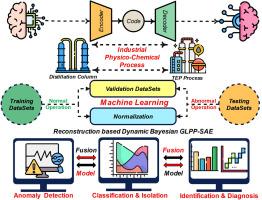复杂工业系统的过程监控与动态融合:基于重构的贝叶斯框架
IF 3.9
2区 工程技术
Q2 COMPUTER SCIENCE, INTERDISCIPLINARY APPLICATIONS
引用次数: 0
摘要
在过去十年中,随着工业4.0到5.0的快速转型,现代工业系统中多个传感器的自动化复杂性和复杂性显着增长。工业4.0到5.0的这种转变仍然没有仔细研究动态监测和融合信息。当评估从复杂的传感器和计算系统收集的复杂信息时,传统的监测技术并不先进,无法解决这些重大挑战。本文提出了一种创新的智能动态融合框架,该框架利用机器学习(ML)和深度学习(DL)来结合动态贝叶斯全局局部保持投影(DBGLPP)、互信息熵(MIE)、堆叠自编码器(SAE)、核密度估计(KDE)和基于重构的贡献(RBC)。新的动态融合框架解决了物理-化学系统的实时动态监测问题。该方法旨在调查、分类、隔离、识别和诊断异常和故障。使用最近建立的模型(如Wavelet-PCA、CWT-3D-CNN、DALSTM-AE)和新提出的动态智能融合监测框架(DBGLPP-SAE)作为模型验证基线,对框架的可行性和功能进行了评估。提出的创新方法已经通过评估乙醇-水精馏塔(DC)和田纳西伊士曼工艺(TEP)作为基准基准进行了测试。结果表明,新型动态智能融合框架能够解决现实世界复杂工业系统的问题和挑战。它可以鲁棒地检测异常,分类和隔离故障,识别根通道,诊断有问题的变量。本文章由计算机程序翻译,如有差异,请以英文原文为准。

Process monitoring and dynamic fusion of complex industrial systems: A reconstruction-based Bayesian framework
In the last decade, the automation complexity and sophistication of multiple sensors in modern industrial systems have grown significantly with the fast transformation from Industry 4.0 to 5.0. This transformation of Industry 4.0 to 5.0 has still not been carefully investigated for dynamic monitoring and fusion information. Traditional monitoring techniques are not advanced to address these significant challenges when evaluating the intricate information collected from sophisticated sensors and computing systems. This paper presents an innovative, intelligent dynamic fusion framework that utilizes machine learning (ML) and deep learning (DL) to combine dynamic Bayesian global-local preserving projection (DBGLPP), mutual information entropy (MIE), stacked autoencoders (SAE), kernel density estimation (KDE), and reconstruction-based contributions (RBC). The novel dynamic fusion framework addresses the issues of real-time dynamic monitoring in physio-chemical systems. The approach seeks to investigate, categorize, isolate, identify, and diagnose anomalies and faults. The framework's feasibility and functionality are evaluated using recently established models such as Wavelet-PCA, CWT-3D-CNN, DALSTM-AE, and the newly proposed dynamic, intelligent fusion monitoring framework (DBGLPP-SAE) as model validation baselines. The proposed innovative methodology has been tested by assessment of the ethanol-water distillation column (DC) and the Tennessee Eastman Process (TEP) as baseline benchmarks. The results and findings showed that the novel dynamic intelligent fusion framework can address the issues and challenges of real-world complex industrial systems. It can robustly detect abnormalities, classify and isolate faults, identify root channels, and diagnose problematic variables.
求助全文
通过发布文献求助,成功后即可免费获取论文全文。
去求助
来源期刊

Computers & Chemical Engineering
工程技术-工程:化工
CiteScore
8.70
自引率
14.00%
发文量
374
审稿时长
70 days
期刊介绍:
Computers & Chemical Engineering is primarily a journal of record for new developments in the application of computing and systems technology to chemical engineering problems.
 求助内容:
求助内容: 应助结果提醒方式:
应助结果提醒方式:


